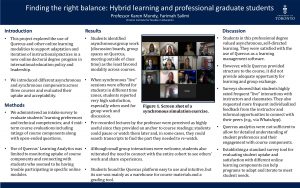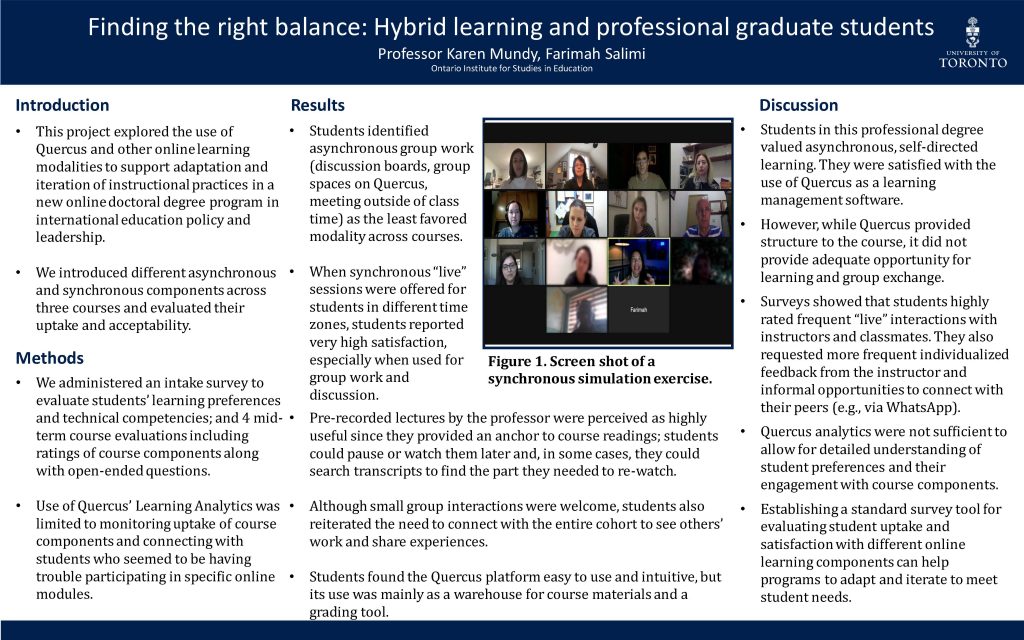Karen Mundy
Course/ProgramLHA3041 – Doctoral Seminar on Policy Issues in Education |
 Poster and Video Presentation – Teaching and Learning Symposium, May 2021 Poster and Video Presentation – Teaching and Learning Symposium, May 2021 |
Design Context
In 2020, OISE launched a new cohort-based online professional doctoral degree in international education leadership and policy. Our project explored the use of Quercus and other online learning modalities to support adaptation and iteration of instructional practices in this new online doctoral degree program. Students in this program are mid-career professionals who are located internationally; they will only meet twice during a four-year program to attend an on-campus research institute. Students follow a common set of 8 courses and need to manage their time online and organize their ideas in preparation for a “dissertation in practice”. We piloted one online course in 2020 for existing doctoral students in order to experiment with instructional practices online. We then continued to experiment with a variety of asynchronous and synchronous learning opportunities once the cohort degree program opened in September 2020, with the aim of finding the right balance of instructional techniques to support online professional learning.
Instructional Challenge
In our first piloted course, we learned that in fully online courses students face challenges in coordinating and contributing equally to asynchronous group work. They want more synchronous online time, and time to reflect on course content and prepare for projects. Course data from 2020/21 showed that students do not favor discussion forums and preferred synchronous online discussion time with the instructor and peers. Coordination of times for synchronous instruction was a challenge for the new doctoral cohort, as they are located in various time zones; and a few students have unstable access to the internet. As a result, we needed to make sure most course content could be delivered asynchronously, while maximizing live interactions for deeper learning activities.
Design Strategy
In designing courses for this special doctoral cohort, we wanted to make sure students received a balance of synchronous and asynchronous learning opportunities. Instructional materials should be easily available for self-paced learning; but students would also be able to collaborate and communicate within their cohort to reap the benefits of learning with peers. Since course work is a steppingstone towards completion of the dissertation in practice, we also wanted to use Quercus as a tool to help students get organized and keep track of how their ideas evolve throughout the program.
We initiated several novel components to support engagement and collaborative learning:
- We relied on asynchronous delivery of lectures and materials. Lectures were pre-recorded.
- We reserved synchronous engagement to bi-weekly tutorial-like Zoom sessions for students, with student discussions, and instructor interventions. Because of time zone differences, two synchronous meetings were held.
- To ensure that students had enough time to work and learn asynchronously, we modified existing 12-week courses into six 2-week modules.
- Instead of using discussion forums to summarize readings and reply to others, in the first course we asked students to reflect on course content and post their reflections in an Ideation Journal shared with the instructor. Since Quercus does not have a true journal function, we created bi-weekly drop box assignments so that students could keep track of their work and of the instructor’s feedback along the way.
- To add the value of peer feedback, we also created peer review assignments and other spaces where students could see each other’s work.
- For the second course in the program, students did group presentations asynchronously by creating their own videos, posting it into small group discussion boards and engaging in discussions.
Use of Data to Inform Design Iteration and Instruction
The use of learning analytics was limited in our design and instruction as most education graduate level courses do not use quizzes. The LMS data that we used to assess participation were the number of page views, posts, and messages to the instructor. We used these data to track non-participation and directly messaging those students to ask if they were having any challenges. However, this data was not able to provide us insights into student engagement with online course materials or with synchronous components of the course. It did not allow us to track student engagement and preferences across the cohort’s courses.
Since our goal was to evaluate and adapt our course design to meet the needs of a new cohort, we administered an intake survey to assess students’ learning preferences and technical competencies; and 3 mid-term course evaluations including ratings of course components along with open-ended questions. Results from these surveys informed much of our iterative design strategy.
Next Steps
While the use of Quercus’ learning analytics in monitoring students learning processes and progress was limited, we found that data from mid-term surveys were a valuable resource to help in adapting and iterating course design. We were able to get consistent input from students about their preferences and needs, and to see how newly piloted instructional formats worked for their learning.
Our surveys showed us that students did not enjoy online discussion boards and preferred synchronous engagement. Beyond this, surveys showed that students wanted more informal opportunities to engage in group exchange and foster the cooperative learning and collegiality that was intended for this cohort of professionals. This led to creation of a WhatsApp group and other synchronous opportunities.
Poster
Presented at the Teaching and Learning Symposium, May 2021.
Click to download poster PDF in a new tab

